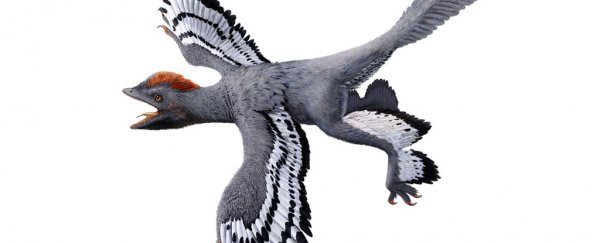While it's no great secret that birds occupy a branch on the dinosaur family tree, describing the steps their ancestors took to develop wings has been no easy task based on bones alone.
Using a technique to light up the near-invisible impressions of soft tissue once belonging to an ancient, bird-like creature, paleontologists have been able to build a more detailed picture of how some dinosaurs eventually took to the air.
Dinosaur meat had a rather unfortunate habit of rotting before it could fossilise, leaving us with little more than teeth, bones, and occasional impressions to hint at what they looked like.
In recent years, a variety of new technologies have allowed us to do more with less, revealing details in fossils such as the pigmentation patterns and hues of dinosaur skin and feathers.
One such dinosaur to have had its true colours revealed is Anchiornis huxleyi – a feathered, crow-sized animal which flapped around what is today China during the late Jurassic period, roughly 160 million years ago.
This relative of Microraptor and Archaeopteryx, all of which belong to a group of bird-like dinosaurs called paravians, was shown to have mostly grey and black plumage, with long white feathers on its arms and legs, and a reddish-brown crest adorning its head.
Applying a technique called laser-stimulated fluorescence to eight different Anchiornis specimens, an international team of paleontologists managed to tease out even more previously hidden details, this time showing traces of skin.
Shining a high powered laser of the right wavelengths onto the fossils made different parts emit slightly different colours, showing patterns which can't be seen in normal light.
The scan confirmed the dinosaur was remarkably bird-like, with drumstick-like legs, scaly feet, and a layer of skin called a patagium linking the sections of its forearm.
This image below gives you some idea of how otherwise invisible folds of skin stand out when stimulated by the laser.
 Wang XL, Pittman M., et al. 2017
Wang XL, Pittman M., et al. 2017
It was this thin ridge of skin which helped show the features that turned dinosaurs into birds were forming over 100 million years before a massive extinction event saw an end to most species.
On modern birds, the patagium produces the smooth aerofoil curve to the front edge of a bird's, bat's, or gliding mammal's wing.
While it's not clear if this implies Anchiornis could fly, it did show the dinosaur's anatomy wasn't far from producing lift.
"The fact that we find this really neat wing in an older bird-like animal is really exciting," said researcher Michael Pittman.
Yet according to a recent paper published in Science by a British paleontologist, the path to the skies was far from a straight line, with features such as feathers and wings providing other advantages in camouflage or ornamentation.
Not all fossils have the right minerals for laser-stimulated fluorescence to be a useful tool, yet it does provide paleontologists with an exciting new way examine a number of specimens in a new light.
"In our opinion, it should be in the top tray of any paleontologist's toolbox, because it can so easily expand the anatomical information available from a fossil without damaging it," Pittman told National Geographic.
Who knows what new discoveries lie not just yet to be unearthed, but hidden away in fossils we've already studied in detail.
This research was published in Nature Communications.
